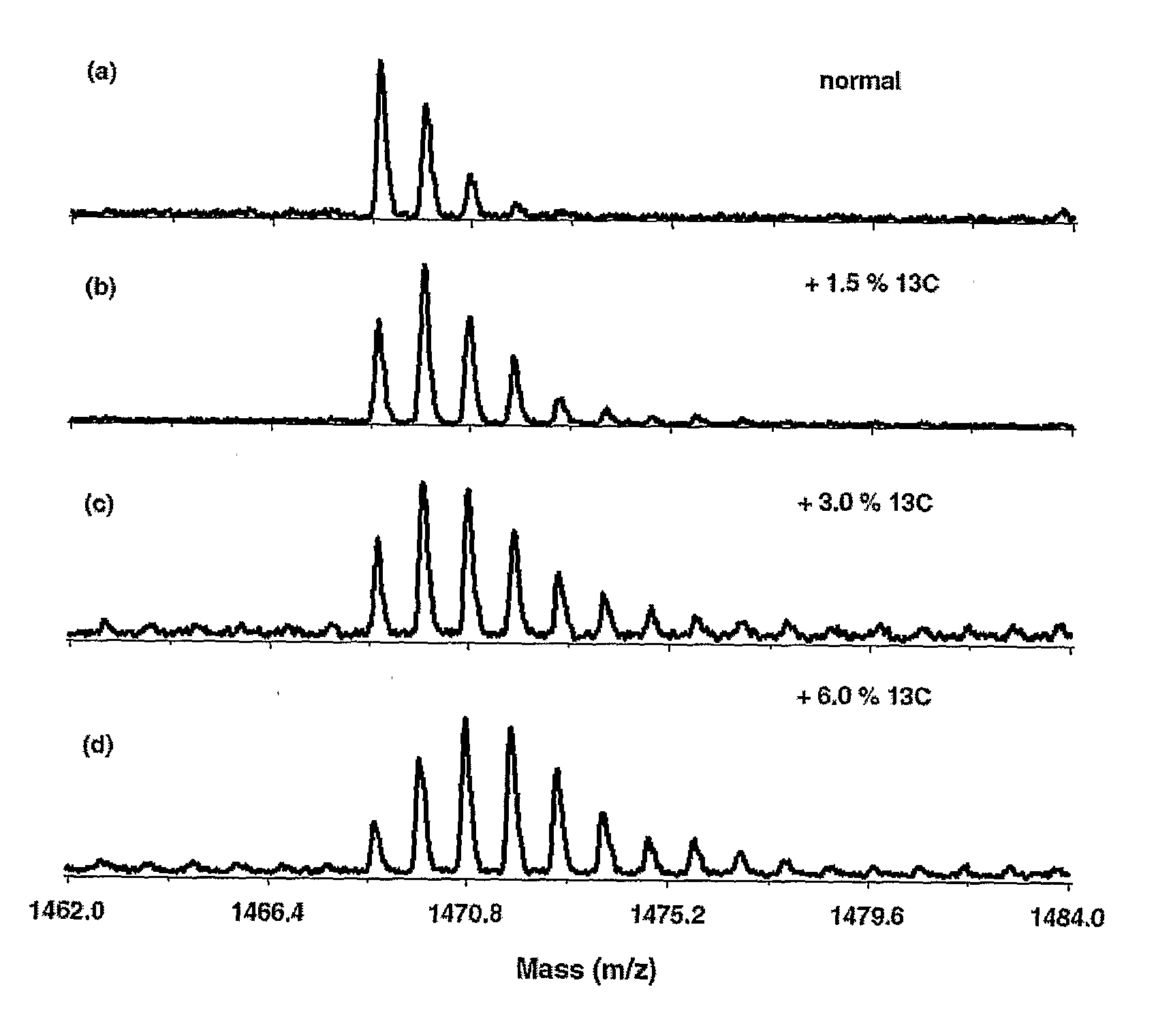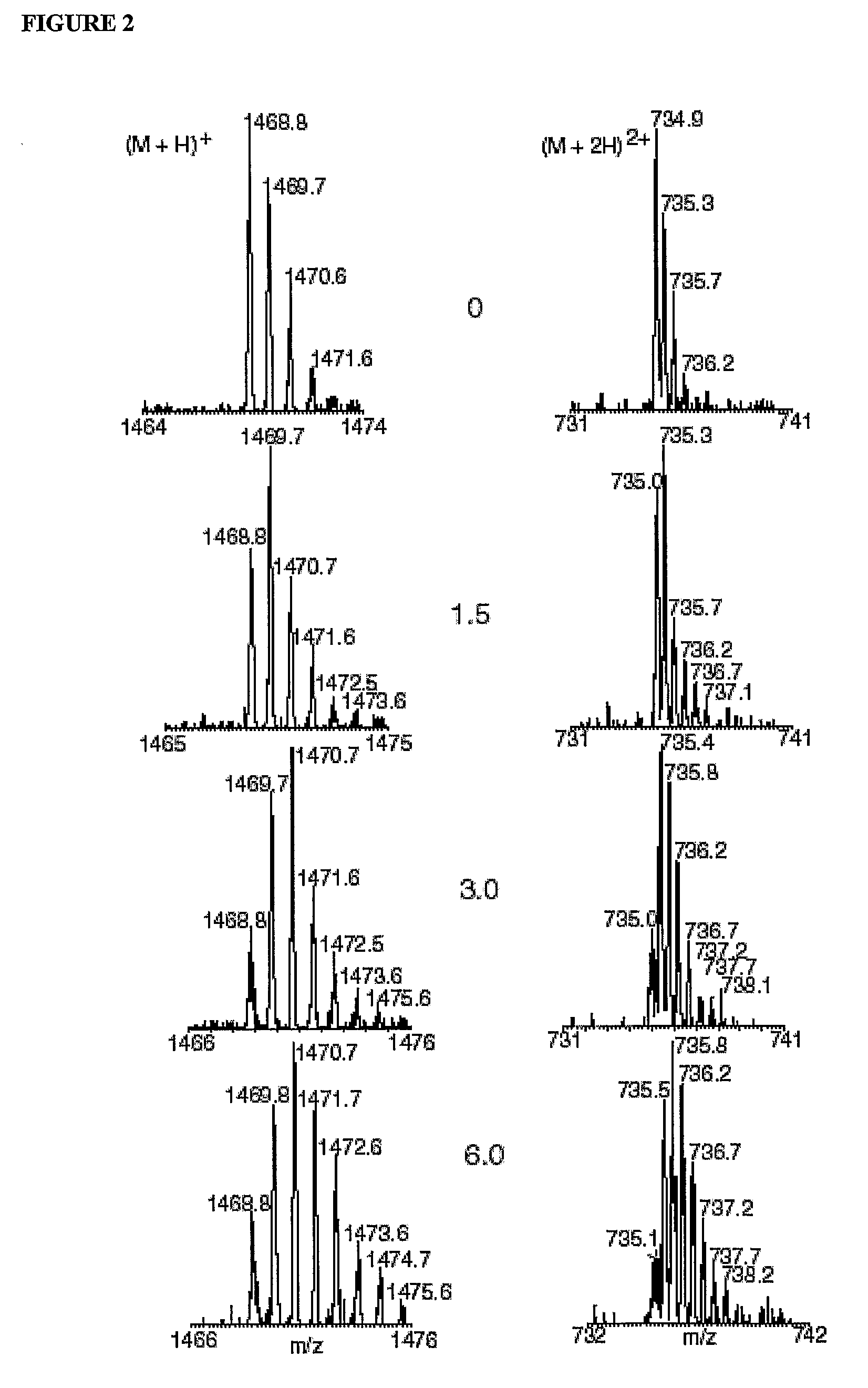System and Method for Expression Proteomics Based on Isotope Ratio Modification
a technology of expression proteomics and isotope ratio modification, applied in the field of expression proteomics, can solve the problems of loss of separation space in the mass spectrometer, significant limitation in its application, and the major challenge of quantitative data
- Summary
- Abstract
- Description
- Claims
- Application Information
AI Technical Summary
Problems solved by technology
Method used
Image
Examples
example 1
Culture of Cells
[0033]Synechocystis sp. PCC 6803 cells were grown autotrophically in liquid BG-11 medium (available from Sigma; St. Louis, Mo.) (Rippka et al., “Generic assignments, strain histories and properties of pure cultures of cyanobacteria,”Journal of General Microbiology, Vol. 111, pp. 1-61 (1979)) buffered with 5 mM N-tris-hydroxymethyl-2-aminoethanesulfonic acid (TES)-NaOH (pH 8.0) (available from Sigma) and supplemented with filter-sterilized mixture of NaH13CO2 (obtained from Cambridge Isotope Laboratories; 99% 13C; Andover, Mass.) and NaH12CO2 (obtained from Sigma, 1.1% of 13C). The bicarbonate mixture was added to the freshly autoclaved BG-11 medium, which contained essentially no dissolved CO2, and the bottles with the medium were sealed until further usage. The added NaH13CO3 was calculated to be 0%, 1.5%, 3.0%, or 6.0% of the total NaHCO3 taking into account natural 13C abundance (˜1 13C / 100 12C) of the standard BG-11 medium (20 mg / l). Cultures were started by inoc...
example 2
Protein Preparation
[0034]Cells were thawed rapidly and placed on ice. Protease inhibitors (obtained from Sigma; P8465; 50 1 / 1 ml aliquot) were added prior to transfer of the cell suspension to tubes containing glass beads (0.1 mm; 1.0-1.2 g) pre-cooled on ice. Cells were broken using a micro-beadbeater (obtained from Biospec Products; Bartlesville, Okla.) on its maximum setting (4-5×30 s). Cells were cooled on ice between each treatment. Cell breakage efficiency was assessed by extraction of cells in acetone (10 μl cells plus 1 ml 80% acetone), agitation and centrifugation; chlorophyll was only extracted after cell breakage yielding a blue pellet. The broken cell suspension was diluted 10-fold with ice cold thylakoid buffer containing protease inhibitors and decanted to pre-cooled centrifuge tubes. Unbroken cells were removed (500 rpm SS34; 1 min) prior to transfer to clean tubes and sedimentation of the membranes (20,000 rpm SS34; 30 min). The supernatant was retained for soluble p...
example 3
Liquid Chromatography Electrospray-Ionization Mass Spectrometry with Fraction Collection
[0035]Samples of Synechocystis membranes were analyzed by LCMS+ (Whitelegge et al., 2002). Membrane fraction proteins (300-600 g) were precipitated at the interface of an aqueous chloroform / methanol phase separation (Wessel and Flugge, “A method for the quantitative recovery of protein in dilute solution in the presence of detergents and lipids.,”Analytical Biochemistry, Vol. 138, pp. 141-43 (1984)) as described (Whitelegge et al., “Toward the bilayer proteome, electrospray ionization-mass spectrometry of large, intact transmembrane proteins,” Proceedings of the National Academy of Sciences of the United States of America, Session 96, pp. 10695-0698 (1999)). Precipitated proteins were recovered after removal of the aqueous phase and addition of methanol. Precipitated samples were dried at atmospheric pressure for 2 min (25° C.) and dissolved in 90% formic acid (available from Sigma; 100 μl) immed...
PUM
| Property | Measurement | Unit |
|---|---|---|
| Force | aaaaa | aaaaa |
| Force | aaaaa | aaaaa |
| Fraction | aaaaa | aaaaa |
Abstract
Description
Claims
Application Information
 Login to View More
Login to View More - R&D
- Intellectual Property
- Life Sciences
- Materials
- Tech Scout
- Unparalleled Data Quality
- Higher Quality Content
- 60% Fewer Hallucinations
Browse by: Latest US Patents, China's latest patents, Technical Efficacy Thesaurus, Application Domain, Technology Topic, Popular Technical Reports.
© 2025 PatSnap. All rights reserved.Legal|Privacy policy|Modern Slavery Act Transparency Statement|Sitemap|About US| Contact US: help@patsnap.com



